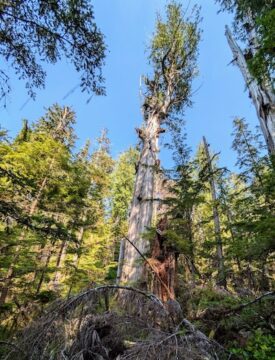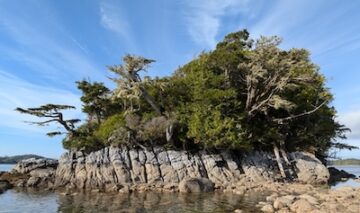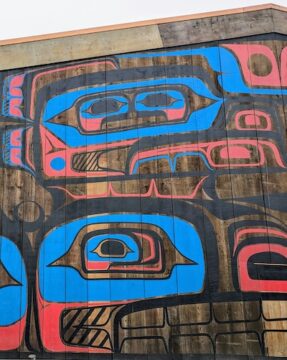by Richard Farr
 The tree was immense even by local standards: a western red cedar that might have been a thousand years old. A botanist would want to measure it; I only wanted to touch its wrinkled face, or kneel among the roots and capture a dramatic snapshot looking up along the trunk. But it was fifty paces away and I couldn’t get there.
The tree was immense even by local standards: a western red cedar that might have been a thousand years old. A botanist would want to measure it; I only wanted to touch its wrinkled face, or kneel among the roots and capture a dramatic snapshot looking up along the trunk. But it was fifty paces away and I couldn’t get there.
We were 300 miles northwest of Vancouver, as the raven flies, on one of the countless islands of the Great Bear Rainforest. The Great Bear covers 25,000 square miles of British Columbia’s Central Coast, which makes it about the size of Sri Lanka. You can get into it by road, sort of, if you take a long, long detour around the back of the coastal mountains to the Bella Coola valley. But water has always been the real road in this maze of islands and inlets, so instead we drove our kayaks to Port Hardy, on the northern tip of Vancouver Island, rolled them onto the ferry, and rolled them off five hours later at the geographical and spiritual heart of British Columbia’s Central Coast, the Heiltsuk community of Bella Bella.
We paddled for twelve days. From the water we saw cormorants and sea otters beyond counting; porpoises; humpbacks. But the land seemed eerily empty, aside from a mink the color of salted chocolate that scampered past my feet one evening. Clawed prints in the sand. A few distant howls in the night. But the bears and wolves, and no doubt many other creatures, were perfectly hidden by the most dominant form of life, tens of millions of trees.
They cover almost everything. On most of the islands, whether fifty square miles or the size of a room, the forest approaches the water like a shoulder-to-shoulder army marching over a cliff, the edge marked by a constant slow-motion falling. The only shore is a yellowish ring of hand-shredding, barnacle-encrusted boulders, fortifications so uniform that it can be hard to finding even the sketchiest place to land. Camping is possible only because some islands have pockets of white sand beach.
Here, for me anyway, was a strange and arresting new experience of wilderness. I’d started out in full Delusional Romantic mode — a Paddler in a Sea of Fog, full of myself for appreciating my own insignificance in these almost limitless spaces. But in all this vastness there was a kind of claustrophobia to be found. You camp on one of the beaches and the sand is pleasantly soft underfoot. Maybe the sun has come out too and is applying a little warmth and UV to your damp malodorous gear. You look around, breathe deeply, and… you can’t visit the land. Beyond the sand, behind the tent, there’s an almost impenetrable green wall.
Almost: rarely, very rarely, there are short rough paths into the forest that previous visitors have created. One of these, three hundred yards long perhaps, connects two beaches across an isthmus. Trying to follow it makes me feel like a creature out of Tolkein: I have to clamber over branches larger than ordinary trees; I fall into pools of mud; I’m not sure I’m still going the right way; I find myself in mossy deeps where strange fungi loom out of the dark and whisper at me. Then, off to one side, I glimpse that especially eye-popping red cedar.
Wanting to get closer, I leave the path through a rat’s nest of salal and climb onto a trunk that has fallen in the right direction. An elevated highway! But the wood is slick and I manage only a couple of dozen small nervous steps before I see that a drop is opening up on either side: five feet, ten, fifteen, into a shadowy chaos of bark, loam, and leafy understory. I have the sensation that there is no forest floor, that the abyss of dying plant matter might go down forever. Ahead of me, across the trunk, the way is blocked by another trunk and its attendant wreckage. I prod, hesitate, back out and try a second route. Then a third, during which I’m attacked by killer brambles and twist an ankle during my escape. No ‘exploring in the forest’ here. The density is like nothing I’ve ever encountered. There’s no way through.
 Robert Falcon Scott was right: “It is good to know that there remain wild corners of this dreadfully civilised world.” But after getting back to our narrow beach and failing to find any other paths, I thought: I don’t belong here. This place belongs to the trees, which are lending it to the bears and the wolves. The forest is saying: ‘Now that you’ve seen this, and appreciated what it really is, don’t come back.’
Robert Falcon Scott was right: “It is good to know that there remain wild corners of this dreadfully civilised world.” But after getting back to our narrow beach and failing to find any other paths, I thought: I don’t belong here. This place belongs to the trees, which are lending it to the bears and the wolves. The forest is saying: ‘Now that you’ve seen this, and appreciated what it really is, don’t come back.’
Later, I wondered if that was just a different kind of Romanticism.
The area around Triquet is a geological anomaly. At the last Glacial Maximum (around 20,000 years ago generally, but 15,000 locally) all western Canada was covered by the mile-thick blanket of the Cordilleran Ice Sheet. It changed the sea level directly but also depressed and then released the land it rested on, so sea levels to the north and south changed by over 100 meters in the millennia that followed its retreat. Here though, sea levels remained stable. The area may have been a continuously habitable refuge.
We knew the Heiltsuk Nation had closed off at least part of Triquet because of a recently discovered archaeological site, a beach that the Clipboard People (from the University of Victoria) have poetically designated EkTb-9. Luckily for us, only the site itself was off limits and we were able to camp. I stood on a rock near where we landed and listened to the Pacific breathing. To the southwest there was 8,000 miles of it, uninterrupted, between me and Tasmania.
EkTb-9 has a shell midden several meters deep and has offered up, among many other artifacts, an atlatl or throwing stick 7,000 years old. But the oldest identified remains, flakes of soot from a campfire and an anvil rock for toolmaking, date twice as far back again, to between 13,000 and almost 15,000 years ago, a mere eyeblink after the ice began to retreat. That meant my dehydrated vegetable soup, bubbling merrily on an isobutane mini-stove, was preceded by the dinners of some of the first humans in North America. They were cooking and eating here ten thousand years before Khufu ordered up a Pyramid.
In some obscure way it made me feel better to discover that those people would not have been hemmed in by an impenetrable forest. Their landscape, so much colder than now, supported only low scrub. From the point of view of their deeper time, the forest is the invader: its giants marched in and began to take over the land only about 6,000 years ago.
Yet the people who lived along this coast learned quickly what a phenomenal gift cedars are. The bark became hats, capes, ropes, and beautiful waterproof baskets. Whole trees became ocean-going canoes — an art the Heiltsuk have been leaders in reviving. And the trees also became great architecture.
 Until the beginning of the twentieth century the center of Heiltsuk life was the ‘Big House’ (Gvúkva’áus Haíłzaqv: House of the Heiltsuk) in Bella Bella. But in a time when potlatches were illegal and much of the tangible and intangible local culture was being suppressed or stolen, it was destroyed — by a storm, according to missionaries at the time, or by the missionaries, in local memory. Potlatches became legal again in 1951. Not long after that, decades of dreaming and planning and fundraising began. Finally, in 2017-19 an extraordinary new Big House was constructed and opened.
Until the beginning of the twentieth century the center of Heiltsuk life was the ‘Big House’ (Gvúkva’áus Haíłzaqv: House of the Heiltsuk) in Bella Bella. But in a time when potlatches were illegal and much of the tangible and intangible local culture was being suppressed or stolen, it was destroyed — by a storm, according to missionaries at the time, or by the missionaries, in local memory. Potlatches became legal again in 1951. Not long after that, decades of dreaming and planning and fundraising began. Finally, in 2017-19 an extraordinary new Big House was constructed and opened.
The front of the new building is covered by a single design nearly 100 feet across representing eagles, ravens, orcas, bears, salmon, wolves, and humans. The entire structure is made from locally harvested cedars, including the meter-wide main beams and four great ceremonial posts that tell key stories. There’s seating for 800 people around an earthen floor and firepit. It’s a sight every bit as awe-inspiring as the cedar I’d seen a week earlier. But what struck me even more than the sight was the scent: if you could breathe in a whole living tree, this is what it would feel like.
Perhaps Romantic notions were creeping over me again, because I couldn’t resist sharing that idea with our guide, one of the Heiltsuk carvers responsible for the Big House. He laughed and shrugged. ‘I’ve been working with cedar all my life — can’t smell it any more!’
*
With thanks to the Heiltsuk Nation for welcoming us into the Big House.
You can watch the Heiltsuk Tribal Council’s short video on constructing the new Big House here, on the first-year celebrations (showing the finished interior) here, and on ‘Building our Constitution’ here.
The Hakai Institute has an excellent page on the dig at Triquet Island here.
